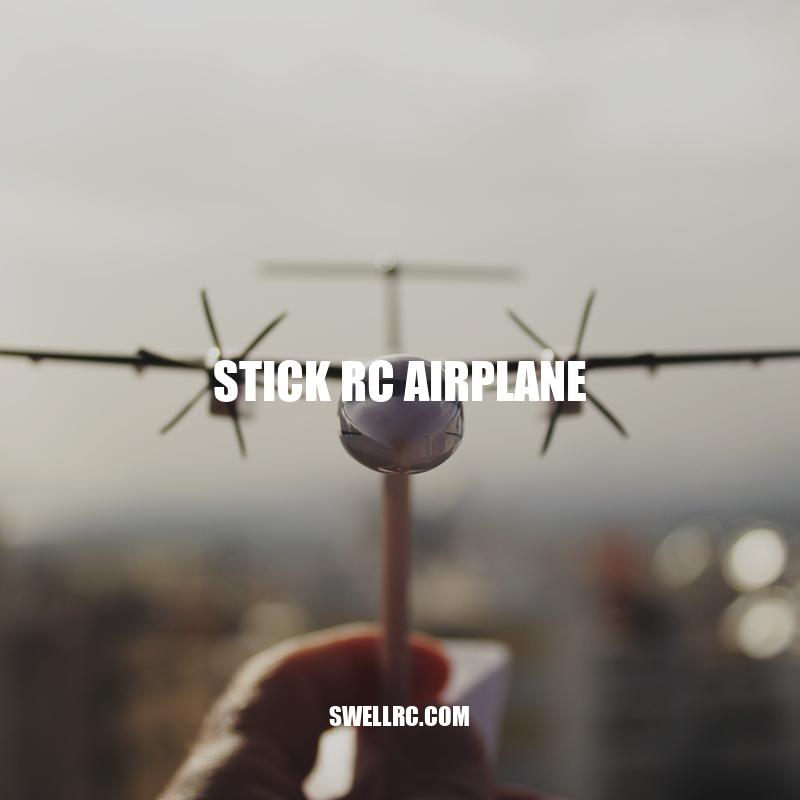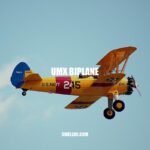Exploring Stick RC Airplanes: Building, Flying and Tips for Success
Stick RC airplanes are among the most popular types of remote control aircraft among hobbyists. Their simple design and relatively easy building and flying processes make them an attractive option for beginners and advanced hobbyists alike. Stick RC airplanes, also called ‘stick and tissue models,’ are typically made from balsa wood and lightweight tissue paper covering. The airframe of a stick RC airplane consists of a simple frame made of balsa wood, with the wings attached via a center support. The motor and propeller are mounted on the front of the frame, and the control surfaces are attached to the tail. Despite their simple design, stick RC airplanes can perform a range of maneuvers, from slow, smooth loops to high-speed rolls and dives. They are versatile and can be used for everything from casual flying to aerobatics and competitions. Building and flying a stick RC airplane can be a satisfying and rewarding hobby, offering a sense of accomplishment and the opportunity to connect with other RC enthusiasts.
The Benefits of Building and Flying a Stick RC Airplane
Building and flying a stick RC airplane offers a range of benefits to hobbyists, including:
- Developing valuable skills: Building a stick RC airplane requires precision, patience, and attention to detail, which can help hobbyists develop valuable skills that can be applied in many areas of life.
- Cost-effectiveness: Stick RC airplanes are generally less expensive to build and maintain than other types of remote control aircraft.
- Customization: Hobbyists can customize their stick RC airplanes by choosing different designs, colors, and decals, giving them a sense of ownership and pride in their creations.
- Social connections: Building and flying stick RC airplanes can be a social hobby that brings together like-minded enthusiasts. Hobbyists can join clubs and communities both online and locally that offer guidance, support, and opportunities to participate in competitions and events.
One website that offers resources and support for stick RC airplane hobbyists is Stick and Tissue. This website provides plans, kits, and information for building stick RC airplanes, as well as forums and resources for connecting with other hobbyists. Additionally, hobbyist and model airplane enthusiast websites such as RCGroups offer forums, discussions, and insights for those interested in this hobby.
How to design and build RC planes?
Designing and building RC planes can be a fun and rewarding hobby. Here are some steps to get started:
- Determine the type of RC plane you want to build
- Research different designs and gather materials
- Create a plan for building the plane
- Build the plane using tools such as a hot wire cutter, sandpaper, and glue
- Add electronics such as a motor and remote control
- Test and adjust the plane as needed
- Enjoy flying your newly built RC plane!
If you are looking for resources and community support, websites such as FliteTest and RCGroups offer information, tutorials, and forums for RC plane enthusiasts. Additionally, products such as the PowerUp 3.0 and PowerUp 4.0 allow you to turn your paper airplane into a remote-controlled aircraft with ease.
The Evolution of Stick RC Airplanes
Stick RC airplanes have been around for many years and have undergone many changes over time. Here are some interesting facts and key developments in the evolution of stick RC airplanes:
- The first stick RC airplanes were designed and built in the 1930s. These early models featured simple balsa wood construction and rudimentary control mechanisms.
- In the 1940s and 1950s, stick RC airplane models became more sophisticated, incorporating more advanced materials such as fiberglass and aluminum.
- The 1960s and 1970s saw a surge in popularity for stick RC airplanes, with hobbyists experimenting with new designs and construction techniques.
- Today, stick RC airplanes continue to evolve with advances in technology and materials.
Here are some key advancements and developments in the world of stick RC airplanes:
| Advancement | Description |
|---|---|
| Electric power | Many stick RC airplanes now use electric motors instead of gas or nitro engines, making them more environmentally friendly and quieter. |
| 3D printing | Advances in 3D printing technology have made it possible for hobbyists to design and build customized parts and components for their stick RC airplanes. |
| Autopilot technology | New stick RC airplane models feature advanced autopilot systems that allow for more precise control and navigation. |
For hobbyists interested in building and flying stick RC airplanes, there are many resources available online, such as Stick and Tissue and RCGroups, that offer support, plans, and advice for getting started in this engaging hobby.
What was the first RC airplane?
The first RC airplane was a model built in 1937 by Edmund Schneider, a German model airplane enthusiast. The plane used rubber-band powered controls to move the rudder, elevator, and throttle. Since then, RC airplanes have come a long way, with many different types of planes and controllers available.
If you’re interested in learning more about RC airplanes, you can check out websites like RC Groups (https://www.rcgroups.com/aircraft-electric-general-electric-all-e-432/) or products like the E-flite UMX Aero Commander (https://www.horizonhobby.com/product/umx-aero-commander-bnf-basic-with-as3x-and-safe-select/EFLU5850.html), a smaller, more beginner-friendly RC airplane.
Building a stick RC airplane can be a rewarding and challenging hobby. Here are some key steps to follow when building a stick RC airplane:
- Choose a design and obtain the necessary plans and materials
- Mark and cut the pieces of balsa wood for the fuselage, wings, and control surfaces
- Assemble the major parts of the fuselage, including the motor mount and wing supports
- Join the wing halves together and install the wing into the fuselage
- Install the control surfaces and linkages, ensuring they meet the proper range of motion
- Add landing gear and other finishing details
- Attach a motor and propeller, and install the necessary electronics and hardware for flight control
While building a stick RC airplane may seem daunting, there are many resources available to assist novice builders. Here are some popular websites and resources that provide guidance and support during the construction process:
- RC Airplane World: Offers tutorials and step-by-step guides for building stick RC airplanes, including tips and tricks for various construction techniques.
- Outerzone: A database of hundreds of vintage and modern stick RC airplane plans available for download.
- Balsa Builder Magazine: An online magazine dedicated to balsa wood construction, offering tutorials and articles on stick RC airplane building.
With the right resources and a willingness to learn, building a stick RC airplane can be a fun and fulfilling experience.
Is it hard to build your own RC plane?
| Difficulty Level | Time Required |
| Intermediate to Advanced | 30-40 hours |
Building your own RC plane can be a challenging but rewarding experience. The difficulty level and time required depend on the complexity of the design. Here’s what you need to know:
- Building an RC plane from scratch requires some knowledge of aerodynamics, electronics, and materials.
- You’ll need tools such as a drill, saw, and soldering iron, and access to a workspace.
- You can find kits that include all the necessary materials and instructions. These can make the process easier and less time-consuming.
- Online resources like RCGroups.com offer forums, tutorials, and advice from experienced builders.
Flying a Stick RC Airplane
Flying a stick RC airplane requires skill and practice, but it can be a thrilling experience once you get the hang of it. Here are some key steps to follow when flying a stick RC airplane:
- Select an appropriate flying location, such as an open field or RC club
- Conduct pre-flight checks on the airplane, including battery and motor tests and control surface movement
- Perform a range check on the control system to ensure that it works within an acceptable radius
- Attempt a test flight to get a feel for the airplane’s handling and responsiveness
- Practice basic maneuvers such as taking off, flying level, turning, and landing
- Gradually progress to more advanced maneuvers such as loops, rolls, and inverted flying
- Practice regularly to improve your skills and knowledge of your airplane’s capabilities
To aid in learning and practicing basic and advanced maneuvers, there are resources available for flying a stick RC airplane:
- The Academy of Model Aeronautics (AMA): Offers safety guidelines, insurance, and educational resources for RC hobbyists of any level. Resources including training programs, webinars, and publications.
- RC Groups Forum: A community of RC hobbyists that share their knowledge and experiences, offering support and feedback. Resources including threads, groups, and discussions regarding flying tips and tricks.
- Stefano Vettori: A Youtube channel offering videos demonstrating how to perform basic and advanced flying maneuvers.
By following safety guidelines, regularly practicing, and seeking feedback and advice, you can hone your skills and enjoy your stick RC airplane to the fullest.
How do you learn to fly RC planes?
- Join a local RC club: Find a local RC club and attend their meetings to gain more knowledge and hands-on experience in flying RC planes.
- Simulator software: Practice flying RC planes with simulator software before flying in real life.
- Build and fly kits: Build and fly RC plane kits to learn about the different components and their functions.
- Attend RC flight schools: Some RC clubs or flight schools offer classes or workshops to train beginners.
Visit rcgroups.com or rc-airplane-world.com for more information about RC planes and flying techniques. Additionally, purchasing a beginner-friendly RC plane such as the HobbyZone Sport Cub S RTF or the E-Flite UMX Radian might be helpful.
Tips for Success
Building and flying a stick RC airplane can be challenging, but these tips can help you succeed:
- Start with a simple design when building your first stick RC airplane
- Pay close attention to detail and follow the instructions carefully
- Avoid shortcuts and take your time during the building process
- Practice proper safety protocols, such as using the correct tools and wearing protective gear when building
- Ask for advice and guidance from experienced RC hobbyists
- Join a local RC club or online forum to connect with other enthusiasts and learn from their experiences
In addition to these tips, there are also websites and products that can help you successfully build and fly a stick RC airplane:
- RC Plane Views: Offers a comprehensive guide for building a stick RC airplane, including materials, tools, and step-by-step instructions.
- RC flight simulator software: An effective way to practice flying a stick RC airplane without risking damage to your actual plane. Using a simulator can also provide a more realistic flying experience and help improve your skills before flying your real stick RC airplane. Examples include RealFlight and Phoenix RC.
- Tower Hobbies: A source for RC airplane kits, tools, and accessories, including those specifically designed for stick RC airplanes.
By following these tips and utilizing these resources, you can increase your chances of success and enjoy the exciting hobby of stick RC airplanes.
How do you fly a plane with a stick?
Flying a plane with a stick, also known as a joystick, involves using it to control three key areas: pitch, roll, and yaw. Pitch controls the plane’s up and down movement, roll controls the plane’s banking or tilting, and yaw controls the tail’s side-to-side movement. Here are the basic steps:
- Use the stick to control pitch by pushing it forward or pulling it back.
- Control roll by moving the stick left or right.
- Move the stick left or right to control yaw.
- Coordinate these movements carefully to achieve steady flight.
Remember, flying a plane with a stick takes practice and skill, and it’s essential to receive proper training and certification.
Check out websites like AOPA.org or FAA.gov for more information on flight training and certification programs.
| Website Name | Description |
|---|---|
| AOPA.org | Provides information about flight training courses, flight regulations, safety and airspace. |
| FAA.gov | Official website of the Federal Aviation Administration, which regulates all aspects of civil aviation in the United States. Provides information about flight training and certification programs, aircraft safety and regulations, and aviation research. |
Conclusion
In conclusion, stick RC airplanes offer a fun and rewarding hobby for aviation enthusiasts and RC hobbyists alike. Building and flying a stick RC airplane can be both challenging and exhilarating, and with the right preparation and resources, anyone can succeed in this hobby. Remember to follow proper safety protocols, take your time in the building process, and consistently practice your flying skills. Don’t be afraid to seek help from seasoned RC hobbyists or online resources like RC Plane Views or RC forums. With dedication and perseverance, you can master the art of stick RC airplanes and experience the thrill of taking to the skies with your own handmade aircraft.



